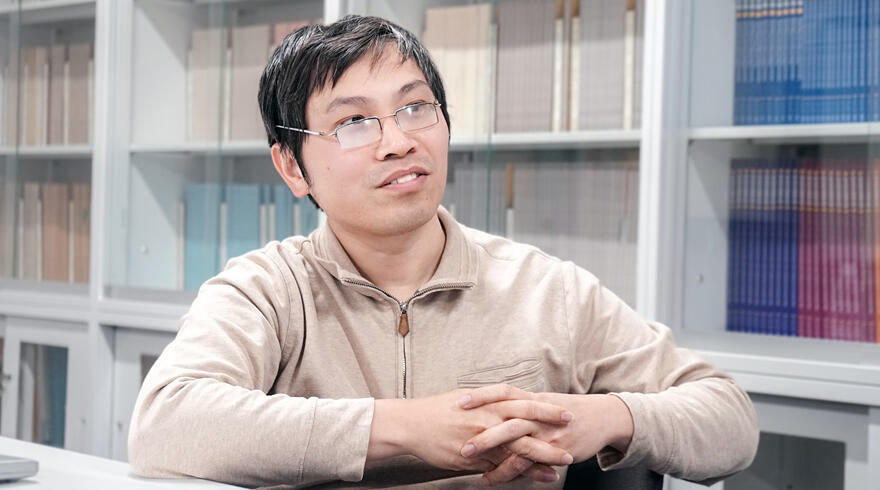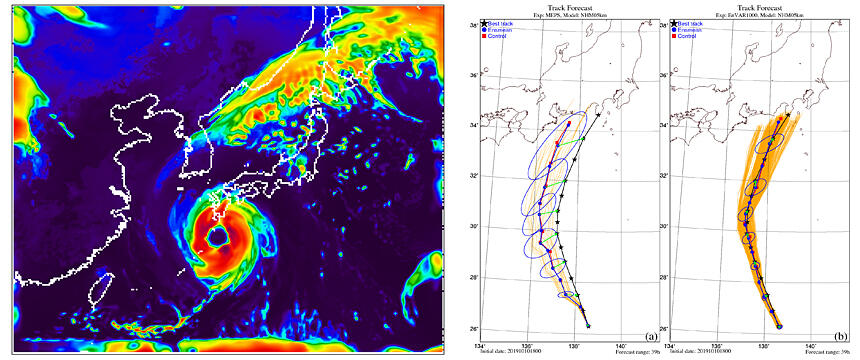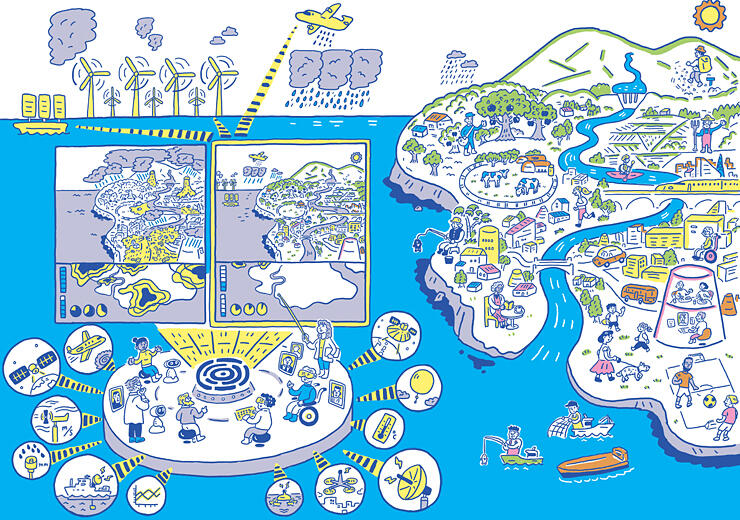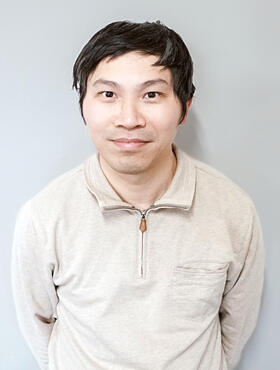The summer of 2023 was the hottest in world history, as temperatures across the globe sweltered. The impacts of El Niño are suggested as one reason why temperature gauges registered so high, and with this forecast to continue into 2024 and beyond, the importance of accurate modelling and prediction of the weather remains strong.
Moonshot Goal 8: Realization of a society safe from the threat of extreme winds and rains by controlling and modifying the weather by 2050 is an ambitious project being undertaken in Japan that aims to make intervention in the timing, range and intensity of typhoons and heavy rains possible and to demonstrate on a computer that reduction of damage from these events can be achieved.
We sat down with Assistant Professor Le Duc, a Vietnamese national working at the University of Tokyo about his experiences in the field of meteorology both in Japan and abroad, the work he is undertaking in data assimilation as part of Moonshot Goal 8, and the importance of international brain circulation, especially in a globally significant field like control of the weather.

From Vietnam to Japan
Le Duc was born and raised in Vietnam and took a particular liking to physics and mathematics during his school years. He was a diligent student, and as a result of his hard work was able to undertake an honor's course at Vietnam National University with a full scholarship. This course was in meteorology and shaped his future career, where today he now focuses on an area called data assimilation. After graduating from VNU Duc moved into a role at the National Center for Hydro-Meteorological Forecasting where he served as Deputy Head of the Numerical Weather Prediction Division.
It was here that he took his first steps towards working in Japan. Duc recalled, "I was lucky to be able to meet with Professor Kazuo Saito from the Japanese Meteorology Research Institute during a business trip to Vietnam. At that time, I was working on a numerical weather prediction model named NHM (Non-Hydrostatic Model), which was developed by Saito. He seemed surprised that we were making use of it and as a result we kept in contact from then."
Following this, the infamous 2011 Tōhoku earthquake and tsunami occurred in Japan. Right after this disaster occurred, Duc was offered a position at the Japan Agency for Marine-Earth Science and Technology (JAMSTEC). As a large and well-known marine and earth science research institute, this was a great opportunity, and despite his colleagues voicing their worries about the risks related to the disaster, he took the chance and moved to Japan. Looking back with a smile he said, "I only planned for a one-year working experience, so I did not worry much about the earthquake and tsunami. However, research projects came up continuously and this has kept me in Japan ever since."
After 10 years at JAMSTEC, Duc was able to put his name on the map in the field of data assimilation, publishing a number of papers in areas such as numerical weather prediction during heavy rains, flood simulations and tropical cyclone forecasting among other topics. As a result of the collaborations involved in their publication, he was able to put together a network of co-researchers in Japan and through this he was introduced to Professor Yohei Sawada and his lab at the University of Tokyo. The lab was looking for a specialist in assimilation, and this was the prompt for Duc to move. He cited the reputation of the University itself, together with the freedom that academic institutes provide as some of the reasons for his move.
The ambitious Moonshot Goal 8: Modelling, forecasting and intervening in the extremely unpredictable
The Moonshot R&D Program targets challenging areas of research with the aim of resolving difficult societal issues, and Goal 8, titled "Realization of a society safe from the threat of extreme winds and rains by controlling and modifying the weather by 2050," is a good example of its extremely ambitious aims. As a specialist in assimilation, Duc is involved as part of a project named 'Control theory of weather-society coupling systems for supporting social decision-making.' He briefly gave a rundown of how he is contributing to the project, stating "I assess the possibility of whether small external forces can significantly change the weather."
As he talked us through his work, Duc brought up the Butterfly Effect, which is related to his modelling. "The flap of a butterfly wing could cause a typhoon. I aim to clarify the small changes in atmospheric states that lead to massive changes in weather systems that mitigate the related disasters. From a practical viewpoint, since all weather systems are large-scale, it is usually taken for granted that huge amounts of energy are required to cause alterations, implying that weather control is only a dream of humankind. But we want to change this viewpoint." Duc attempts to combine different sources of information to estimate possible states of a system as it evolves over time, and small shifts in energy have the potential to cause massive changes in the state of the system.

Provided by Duc
An important aspect of the Moonshot Program is that each must aim to make a positive contribution to future society, and Goal 8 follows this. While control of the weather is a lofty objective, a number of intermediary outcomes are also expected from the project. The first is deepened knowledge of extreme weather events such as heavy rains and tropical cyclones. With deeper understanding new observation techniques are expected, especially in areas such as tropical cyclones. It is impossible to observe the inside of these with conventional techniques, aircraft or ships due to the danger involved, and new remote sensing techniques are needed to cover this weakness. New forecasting techniques are also expected with the overall goal of the project to develop feasible weather intervention technologies.
In regard to these interventions, Duc shared a few examples of the types of technologies that are currently available. "The first technique used in weather control was cloud seeding, which was used for the first time in the USA around 50 years ago to intervene in hurricanes and tropical cyclones. Recently a number of other techniques have been developed. One of these is 'bumping,' where a large system is developed at the bottom of the ocean to 'bump' the cold water up to the surface. A lot of the energy used by tropical cyclones comes from the sea surface, and if you can reduce the temperature of the water, you can reduce the intensity of the cyclone. Another example here in Japan, is a machine that can absorb humidity in the air. Heavy rain comes from humidity, so if it can be totally absorbed heavy rains can be stopped, the issue is developing a system over such a large region." While many breakthroughs are required to achieve the Moonshot Programs ultimate aim, good work is being done by the researchers involved towards achieving it.

International brain circulation
Weather forecasting and control of extreme events is important throughout the world, and international mobility and the movement of talent is an important aspect of promoting the development of these technologies. As a Vietnamese national, Duc is a great example of international brain circulation.
Duc shared his experiences in both countries, "The biggest difference is the research infrastructure. In Japan, I can easily access supercomputers (He has used both the K supercomputer and Fugaku) to support my research. Because of the economic gap between the two countries, having access to a supercomputer is not easy in Vietnam. Meteorological databases are also widely available in Japan, which enhances my research abilities. Furthermore, there are plenty of international workshops and conferences here that allow me to meet with experts in the same field to exchange research ideas and knowledge." Duc has also had opportunities to undertake study and research in various European countries, such as Italy, Germany, and Finland, and credited these international experiences as important parts of his journey as a researcher.
In terms of a base to undertake weather-related research, he heaped high praise on Japan. Due to its geographical location and geology, the country has a number of different weather systems, and many phenomena can be observed, such as tropical cyclones, heat waves and heavy snow. Duc described the country as "an enormous meteorological laboratory," adding "I feel that there is no need to worry about the limitation of research topics, as we always have some kind of extreme weather event to do research on every year." While his home country of Vietnam experiences a number of similar weather events, the wide scope available for research and modelling have been of great help to Duc in his research career and highlight the benefits of international brain circulation.
He also had some words for those looking to work in both meteorology and in Japan. "Both physics and mathematics can be applied in the field, so if those are your interests and you want to challenge yourself, then meteorology is definitely a good choice." In terms of Japan, he linked its technological position and Big Data as drawcards. While the term is gaining traction in a wide number of fields, it has been widely used in meteorology for some time, and in recent years big tech companies have been competing to use AI-assisted weather forecasting systems. Japan remains near the cutting edge of these fields and is an attractive place for research.
Regarding challenges, he brought up the language, saying "Japanese is very different, not only from Vietnamese but also from English. The structure is the opposite way around! Vietnamese has the same grammatical structure as English, so this is very difficult. The writing system is also very different, you need to memorize kanji, the Chinese characters. However, if you can overcome these, I think it is wonderful to live in Japan." Japan is striving to internationalize, and many institutes are currently working towards making English the main language used in research.
Forecasting the future
Just like how the weather is full of prediction and uncertainty, so too is the future. "It depends on the weather!" Duc answered with a smile when we asked about his long-term plans, "However, I believe that I will continue to stay in the field and keep challenging myself with changes in global weather patterns."
His work in data assimilation relies on technology, and he also expects that this will continue into the future. Supercomputers and sophisticated observation systems are still the backbone of weather modeling, and with the advent of quantum computing, there are high expectations for the role that it can play in the future with several researchers having already developed data assimilation algorithms to run on these computers. IoT devices can provide a huge number of observations for any weather model. Integration of state-of-the-art machine learning techniques into numerical weather prediction is also expected to significantly change the way that weather forecasts are produced. Duc predicted, "The next evolution of weather forecasts will be when we see the fusion of AI and our physical observation techniques."
One potential issue with the rise of technology in weather forecasting is data storage. "We work with petabyte sized data storage nowadays, but even this is not big enough to store all of the data we use. In weather forecasting we need to use ensemble forecasts, and for that we need scenarios, and many runs of the same model under different scenarios. In the Moonshot project we aim to run 1000-10000 forecasts, this requires a large amount of storage.
Another concern is the cost associated with analysis. "One technique we have is called 'reanalysis.' Training data for an AI comes from some weather system, and we use this data set to train AI. But there are currently limitations on resolution, which currently is capped at around 20-25km. This is still a big challenge, and I heard that when you train an AI on this kind of data, it costs $1M dollars. Which means that this is only affordable by big tech companies and is a major problem!"
Despite the inherent uncertainty in weather systems, and the high technological requirements of the field, Duc continues to work hard in the field of meteorology and data assimilation. We look forward to hearing more from him and Moonshot Goal 8 in the future as they seek to predict and control the weather to realize a society safe from the threat of extreme winds and rains.

Profile
Le Duc
Born in Vietnam. Graduated with honors from Vietnam National University and proceeded to obtain a PhD (Meteorology) from the same institute. Served as Deputy Head of the Numerical Weather Prediction Division at the National Center for Hydro-Meteorological Forecasting in Vietnam, before moving to Japan to take up a role at Japan Agency for Marine-Earth Science and Technology (JAMSTEC). Following this, he moved to the Japan Meteorological Business Support Center, before taking up his current position as an Assistant Professor at the University of Tokyo. Concurrently serves as a Visiting Scientist at the Meteorological Research Institute, Japan Agency of Meteorology.
Links
Moonshot Goal 8: https://www.jst.go.jp/moonshot/en/program/goal8/
Science Beyond Limits Podcast: https://www.youtube.com/watch?v=0lJ1gJURGzY
Dr. Le Duc: https://sites.google.com/view/le-duc/home
Produced by the Science Japan Editorial Team.




